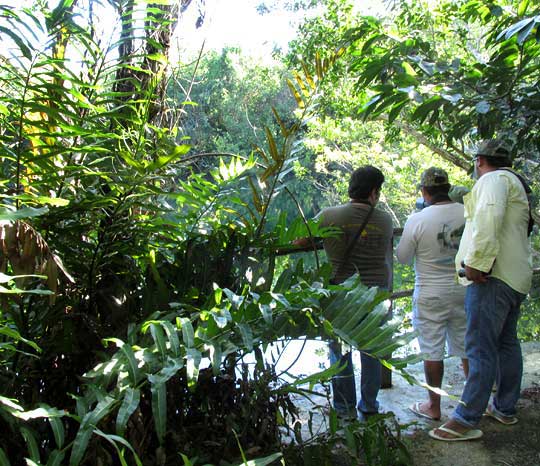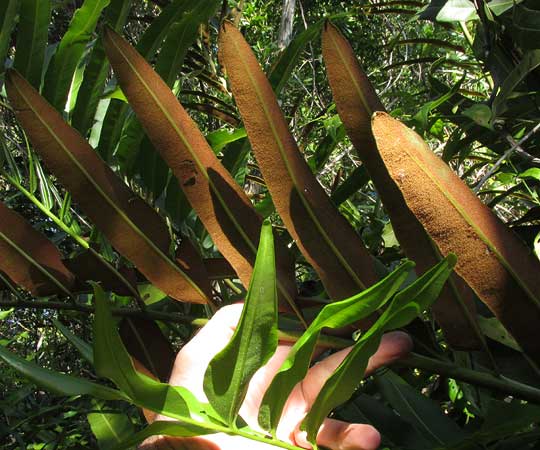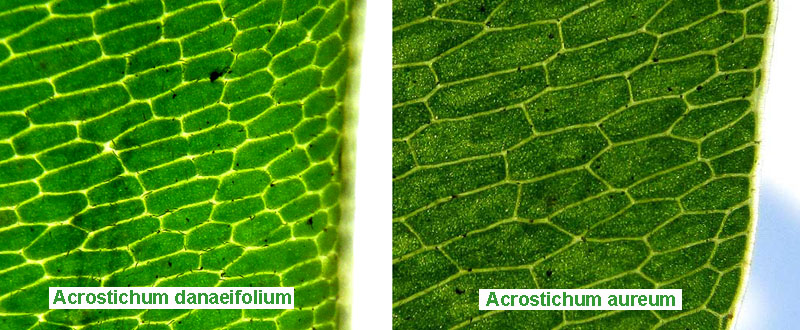Excerpts from Jim Conrad's
Naturalist Newsletter
from the January 11, 2015 Newsletter issued from Río Lagartos, on the Yucatan Peninsula's northern coast (~N21.60°, ~W88.16°), Yucatán state, MÉXICO
GOLDEN LEATHER FERN
One place to see ACROSTICHUM AUREUM, often called Golden Leather Fern or Mangrove Fern, is beside the pond known as Petén Tucha, the same spot deep inside the mangroves where the spider monkeys dropped unripe figs onto the forest floor. Below, you can see some of my students crocodile watching at Petén Tucha next to a shade-loving Golden Leather Fern standing about ten feet tall (3m):

A close-up look at parts of two fronds, with fertile, spore-producing pinnae at the top and sterile pinnae at the bottom, is shown below:

Golden Leather Ferns occur in coastal mangrove swamps, salt marshes, low hammocks, and along lake and canal margins worldwide in tropical and subtropical regions, including in Florida in the US.
With such a large distribution area it's to be expected that some culture someplace uses Golden Leather Fern medicinally. In Fiji it's been documented as used to promote healthy pregnancies, for sinus problems, sore throat, wounds, elephantiasis, to bring down fever, and to deal with chest pain.
from the January 11, 2015 Newsletter issued from Río Lagartos, on the Yucatan Peninsula's northern coast (~N21.60°, ~W88.16°), Yucatán state, MÉXICO
FINE-TUNING THE LEATHER FERNS
Back in 2006 during my first visit with Diego I profiled the Giant Leather Fern, Acrostichum danaefolium, which grew robustly and impressively out in the sun-drenched marshes. You can see the fern we looked at then at www.backyardnature.net/yucatan/acrostic.htm.
However, two giant leather fern species are listed for the Yucatan, Acrostichum danaefolium and Acrostichum aureum. I was pretty sure that our marsh-dwelling one was Acrostichum danaefolium, but would I recognize Acrostichum aureum if I came across it? The Flora of North America and other technical treatments all appear to be in general agreement about differences between the two species. On fronds of A. aureum, only the outermost segments, or pinnae, produce spores, while on A. danaeifolium the spore-producing pinnae occur throughout most of the frond. Aureum's pinnae don't overlap but danaeifolium's more or less do. And the cells, or "areoles," formed by the smallest veins at the edge of the pinnae are narrow in aureum but broad in danaeifolium.
After paying attention to hundreds of leather ferns in this area it's gradually dawned on me that we do have two distinct forms here, one thriving in full sunlight in grassy marshes, while the other lives in shadowy mangroves. However, the field marks outlined above haven't helped at all. The fronds of both species lose pinnae at their bottoms as they age, whether they're spore producing or not, so it's hard to say how much of a frond is spore producing. "More-or-less overlapping pinnae" appeared on both forms. Also,I've photographed areoles" at the edge of the pinnae of the two forms, and they're shown below:

I just don't see that much difference" between them. The different sizes might be accounted for by the camera lens being at different distances from the pinnae. Even drawings of areoles in the Flora of North America don't clearly indicate the differences described between them. Maybe this is one of those times when experts generation after generation copy from one another with no one ever checking to see if what's written coincides with reality.
Still, something else said in the Flora of North America, where the situation is described in Florida where the two species coexist, fits perfectly what I find here. That is, "Acrosticum aureum is more frequently found in coastal shaded areas, in saline black-mangrove communities ... Acrostichum danaeifolium grows vigorously in full sun and is common and widely distributed in Florida."
That fits the two "forms" I've recognized here, so I continue to call the much more commonly found marsh-and-full-sun one Acrostichum danaeifolium, and the ones occurring in deep shade and often in standing water in the mangroves now I'll designate as Acrosticum aureum, often called the Golden Leather Fern.